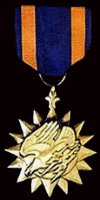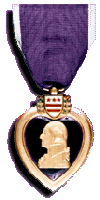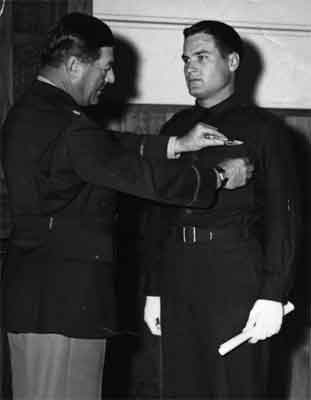Funeral Services:
AUB L ATKINS, SERGEANT, USA POST CHAPEL 1:00
ANTONIO P CALDERON, PRIVATE FIRST CLASS, USA POST CHAPEL 1:00
RICHARD P GRUTZA, CORPORAL, USA POST CHAPEL 1:00
CHARLES L MAGGART, FIRST LIEUTENANT, USA POST CHAPEL 1:00
WILSON L PINKSTAFF, FIRST LIEUTENANT, USA POST CHAPEL 1:00
WILLIAM N STOCKING, SECOND LIEUTENANT, USA POST CHAPEL 1:00
FRANK THOMPSON, SECOND LIEUTENANT, USA POST CHAPEL 1:00
The group burial involving the following soldiers has been scheduled 17th November 2009 at 1300hrs in Arlington National Cemetery.
First Lieutenant Charles L. Maggart, First Lieutenant Wilson L. Pinkstaff, Second Lieutenant Frank (NMI) Thompson, Second Lieutenant William N. Stocking, Sergeant Aub Lee Atkins, Corporal Richard P. Grutza, Private First Class Antonio P. Calderon.
The individual remains of Second Lieutenant William N. Stocking will be interred next to the group casket on the same day.
Aub L. Atkins, Jr.
Sergeant, U.S. Army Air Forces
Service # 14053731
405th Bomber Squadron, 38th Bomber Group, Medium
Entered the Service from: Louisiana
Died: 5-Dec-42
Missing in Action or Buried at Sea
Tablets of the Missing at Manila American Cemetery
Manila, Philippines
Awards: Air Medal, Purple Heart
Antonio P. Calderon
Private First Class, U.S. Army Air Forces
Service # 38013441
405th Bomber Squadron, 38th Bomber Group, Medium
Entered the Service from: New Mexico
Died: 5-Dec-42
Missing in Action or Buried at Sea
Tablets of the Missing at Manila American Cemetery
Manila, Philippines
Awards: Air Medal, Purple Heart
Richard P. Grutza
Corporal, U.S. Army Air Forces
Service # 16047009
405th Bomber Squadron, 38th Bomber Group, Medium
Entered the Service from: Wisconsin
Died: 5-Dec-42
Missing in Action or Buried at Sea
Tablets of the Missing at Manila American Cemetery
Manila, Philippines
Awards: Air Medal, Purple Heart
Charles L. Maggart
First Lieutenant, U.S. Army Air Forces
Service # 0-430935
405th Bomber Squadron, 38th Bomber Group, Medium
Entered the Service from: Indiana
Died: 5-Dec-42
Missing in Action or Buried at Sea
Tablets of the Missing at Manila American Cemetery
Manila, Philippines
Awards: Air Medal, Purple Heart
Wilson L. Pinkstaff
First Lieutenant, U.S. Army Air Forces
Service # 0-424664
405th Bomber Squadron, 38th Bomber Group, Medium
Entered the Service from: Illinois
Died: 5-Dec-42
Missing in Action or Buried at Sea
Tablets of the Missing at Manila American Cemetery
Manila, Philippines
Awards: Air Medal, Purple Heart
William N. Stocking
Second Lieutenant, U.S. Army Air Forces
Service # 0-434888
405th Bomber Squadron, 38th Bomber Group, Medium
Entered the Service from: Texas
Died: 5-Dec-42
Missing in Action or Buried at Sea
Tablets of the Missing at Manila American Cemetery
Manila, Philippines
Awards: Air Medal, Purple Heart
Frank Thompson
Second Lieutenant, U.S. Army Air Forces
Service # 0-659607
405th Bomber Squadron, 38th Bomber Group, Medium
Entered the Service from: California
Died: 5-Dec-42
Missing in Action or Buried at Sea
Tablets of the Missing at Manila American Cemetery
Manila, Philippines
Awards: Air Medal, Purple Heart
Demise of “The Happy Legend” by Phil E. Maggart (brother)
The aircraft was nicknamed “The Happy Legend” but it had previously been named “Scat” . It was on a mission to Buna on 5 December 1942 when it was lost. Australians found the crash in the Owen Stanley Mountains in February of 1943. The bombs were still onboard which indicated that they were possibly shot down. Wilson Pinkstaff’s remains were identified and Aubrey Atkin’s identification tags were found. The Japanese ground forces were in the immediate area and the team had to terminate the search for additional remains of the crew.
Michael Claringbould, an Australian who is a World War II buff, was very helpful after I forwarded an informative letter from Mike Boccio. He was able to pin point the exact location of the crash sight Michael forwarded the MIA report and some ancillary information concerning the loss of Charles. Claringbould asked if I would like the Central Identification Laboratory CILHI to reopen the crash site and search further for remains, since the crew is still listed as Missing In Action. Consent to this procedure has been granted; however, after 60 years it doubtful that there is anything to find.
Charles Landon Maggart
This is a story of Charles Landon Maggart, contributed by his brother, Philip Maggart. Charles Landon was name after both of his grandfathers. In high school he had a 1937 Harley Davison Motor Cycle and all the girls liked to ride with him. During summer vacations and on weekends he worked for dad as a truck driver delivering bread. The route that took other drivers normally all day to complete, he was able to do in half a day. He was selected to be the quarterback for the All Indiana Football Team; subsequently he won a scholarship to both Indiana University and The University Of New Mexico. New Mexico seemed intriguing, so off to Albuquerque he went in 1938 to fulfill the scholarship requirements. While there he became a Sigma Chi, and was involved in many social and academic endeavors. One summer vacation mother received a call from Charles in San Francisco wanting money to return to Indiana. Dad wanted to know how he got out there and Charles answered, “Hitch Hiked”. Dad’s response was a terse, “Hitch Hike Home.”
Joining Army Air Corp
The winds of war seemed imminent in Europe and he decided to return to Marion and attend the local Marion College while taking flying lessons from a young black instructor pilot named Jackson. After completing two years of college he applied for pilot school with the Army Air Corps, being accepted April 5, 1941. He departed Indianapolis with Robert Sternburger from Indianapolis for Parks Air College, St. Louis, Missouri. He completed primary training in PT-13 aircraft, followed by advanced training at Randolph Field, Texas where his leadership abilities gained him the rank of Cadet Sergeant Major for the Cadet Battalion. (Mr. Stern Burger was located January 21, 1999 in Hawaii, through an ad in the Air Force magazine). The infamous day of Dec 7, 1941 found him ready to graduate from advanced flying school at Ellington Field, Houston, Texas in Class of 41-I.
Marrage & Unit Assignment
While at Randolph he contacted food poisoning where up on he was hospitalized for several days, finally being nursed back to health by 2nd Lieutenant Yolanda Federico, sparking a new romance. Before leaving Marion for pilot school he became engaged to Eloise Toll, a high school sweetheart that was terminated for his newfound girlfriend. (July 14, 2001, Eloise sent me several pictures and a letter that he wrote to her from Randolph). He and Yolanda Federico were finally married on graduation day and the next day departed for Morrison Field, Florida for assignment to the 49th Pursuit Group, 9th Pursuit Squadron. Upon completing fighter upgrade training at Morrison Field, the pilots were issued first aid kits, dated 1917. We were realy prepared!
Advanced Training & Overseas
After two weeks of training in the P-40’s the Group was transferred to Melbourne, Australia. Japanese were marching down New Guinea and were seriously threatening Australia. General Douglas Macarthur was the Supreme Allied Commander and reorganized the ground forces to regain a foothold in New Guinea. The P-39s were of little use and consequently many of the pilots were transferred into the 38th Bomb Group (Medium) flying B-25s.He was assigned initially to the 38th Bomb Group Headquarters. Notice the Patch on his flying jacket. This was the 38th Headquarters Logo. The 38th Bomb Group departed California, April 1942 and flew across the Pacific Ocean to Australia, Island hopping as much as possible.
Combat Missions
Charles was assigned to the 71st Bomb Squadron and later to the 405th as aircraft were destroyed, squadron integrity was lost. He was engaged in the many major missions during his short tour with the 38th Bomb Group; however, this cannot be verified as his active duty records have never been located. Several attempts were made through the Department of Army Records Personnel Center in Alexandria, Virginia. and the Central Personnel Records Center, St. Louis, Mo. The same answer, “If the records were in the Center in 1973, they were destroyed by a fire.”
What Happened to Charles Maggart?
Information about the 38th Bomb Group organization was obtained and through it I have been able to gain some factual data. After becoming an associate member, an add was run in the Sun Setter Magazine asking for assistance in this case. It was phenomenal the number of responses that was received. The best lead came from Garrett Middlebrook’s book, “Combat at 20 Feet.” A chapter is reproduced that explains how Charles’ aircraft was shot down. Garrett wrote to me and gave his personal insight of what happened December 5,1942. His account has been substantiated by subsequent accounts.
It was through the media of the Sun Setters Newsletter that a great number of responses were received either through the telephone or by letter. Many of the telephone responses were individuals who recalled Charles but never new the actual circumstances as to how he was became an MIA. My best lead was through Garrett Middlebrook’s book. Chapter Six is a short narrative of the actual events of the December 5 1942 raid as he remembered it. This account was consistent with a letter received from Col. Isam Johnson He wrote two personal letters that also reflected his anguish of losing two very close friends on that aircraft.
Friday will be the 66th anniversary of the crash of the Happy Legend, a U.S. military plane that was conducting a bombing mission against the Japanese in Papua New Guinea during World War II.
Among the seven killed in the crash was Marion native First Lieutenant Charles L. Maggart.
Since then, his younger brother, Phil Maggart, has made it a mission to recover the remains of his brother.
After a decades-long search that has snowballed recently because of technology and the Freedom of Information Act, Army officials told Maggart they were able to identify remains of four of the seven crew members aboard the Happy Legend — but not his brother.
Maggart and his wife, Carol, were visited in their Marion home Tuesday by Johnny Johnson, a senior mortuary affairs specialist with the Army Human Resources Command, and Angelique Averett, a captain with the Army’s joint force headquarters in Indiana.
Johnson presented the Maggarts with a book containing detailed information about the crash site, beginning with its discovery in 1943 by the Australian Army as it chased Japanese forces out of the country.
“Hopefully some of the information can bring you some closure,” Johnson told the Maggarts.
The site was then visited more than a dozen times over the course of several decades, with the most recent trips made in 1995, 2001, 2002, 2004 and finally in 2005. The last trip resulted in an archeological dig in which 19 samples of remains were retrieved.
“This was a thorough archeological excavation,” Johnson said.
Four men were positively identified from that work, the Army announced in September. But Charles Maggart was not among them.
Johnson explained that U.S. military policy is that any unidentifiable remains recovered from a crash site represent all people killed in the crash.
Those remains will be buried in the spring in Arlington National Cemetery, and the Army will fly Phil Maggart and two family members to northern Virginia, put them up in a hotel and have memorial and burial services with full military honors.
The Maggarts also will be able to meet the surviving families of the other soldiers killed in the plane crash.
Phil and Carol expect to travel to Arlington for the event. Phil believes his sons Charles and John will also make the trip with them.
For Phil, this is nearly the final chapter of 66 years of work by him and his parents and another brother, who are now deceased.
“It’s over,” he said. “It’s something that’s been going on since we lost him on December 5, 1942.”
The officers’ visit was a great experience, and the book contains a lot of information he had not previously seen, Phil said.
“I thought it was very informative,” he said. “They filled me in on a lot I didn’t know, and a lot I did.”
Johnson said his department still actively searches for the remains of U.S. personnel in World War II, Korea and Vietnam. He said there are still more than 30 teams in the Pacific theater and Europe that investigate crash sites.
He also said the military gets a lot of help from retirees and professional “hunters” who search for traces of war at remote sites that were once battlefields.
“There are a lot of great people that help us,” Johnson said.
Maggart had been informed earlier this year that his brother’s remains had been identified from those recovered at the Papua New Guinea crash site. But he was then contacted by Johnson weeks later and informed that Charles had not been among those identified.
Maggart said he’s happy to have resolution on his 66-year search.
“It was a terrible experience,” he said. “It’s one of those things that we go through in the war experience.”
Charles Maggart was 23 years old when he was killed in action. He was a graduate of Marion High School and an athletic star at Marion College (now Indiana Wesleyan University) and the University of New Mexico.
Michael Robert Patterson was born in Arlington and is the son of a former officer of the US Army. So it was no wonder that sooner or later his interests drew him to American history and especially to American military history. Many of his articles can be found on renowned portals like the New York Times, Washingtonpost or Wikipedia.
Reviewed by: Michael Howard










